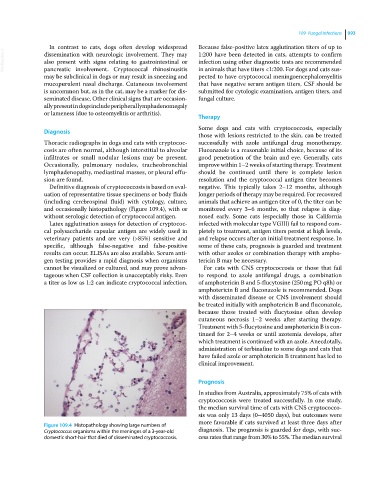Page 1055 - Clinical Small Animal Internal Medicine
P. 1055
109 Fungal Infections 993
In contrast to cats, dogs often develop widespread Because false‐positive latex agglutination titers of up to
VetBooks.ir dissemination with neurologic involvement. They may 1:200 have been detected in cats, attempts to confirm
also present with signs relating to gastrointestinal or
infection using other diagnostic tests are recommended
pancreatic involvement. Cryptococcal rhinosinusitis
may be subclinical in dogs or may result in sneezing and in animals that have titers <1:200. For dogs and cats sus
pected to have cryptococcal meningoencephalomyelitis
mucopurulent nasal discharge. Cutaneous involvement that have negative serum antigen titers, CSF should be
is uncommon but, as in the cat, may be a marker for dis submitted for cytologic examination, antigen titers, and
seminated disease. Other clinical signs that are occasion fungal culture.
ally present in dogs include peripheral lymphadenomegaly
or lameness (due to osteomyelitis or arthritis).
Therapy
Some dogs and cats with cryptococcosis, especially
Diagnosis
those with lesions restricted to the skin, can be treated
Thoracic radiographs in dogs and cats with cryptococ successfully with azole antifungal drug monotherapy.
cosis are often normal, although interstitial to alveolar Fluconazole is a reasonable initial choice, because of its
infiltrates or small nodular lesions may be present. good penetration of the brain and eye. Generally, cats
Occasionally, pulmonary nodules, tracheobronchial improve within 1–2 weeks of starting therapy. Treatment
lymphadenopathy, mediastinal masses, or pleural effu should be continued until there is complete lesion
sion are found. resolution and the cryptococcal antigen titer becomes
Definitive diagnosis of cryptococcosis is based on eval negative. This typically takes 2–12 months, although
uation of representative tissue specimens or body fluids longer periods of therapy may be required. For recovered
(including cerebrospinal fluid) with cytology, culture, animals that achieve an antigen titer of 0, the titer can be
and occasionally histopathology (Figure 109.4), with or monitored every 3–6 months, so that relapse is diag
without serologic detection of cryptococcal antigen. nosed early. Some cats (especially those in California
Latex agglutination assays for detection of cryptococ infected with molecular type VGIII) fail to respond com
cal polysaccharide capsular antigen are widely used in pletely to treatment, antigen titers persist at high levels,
veterinary patients and are very (>85%) sensitive and and relapse occurs after an initial treatment response. In
specific, although false‐negative and false‐positive some of these cats, prognosis is guarded and treatment
results can occur. ELISAs are also available. Serum anti with other azoles or combination therapy with ampho
gen testing provides a rapid diagnosis when organisms tericin B may be necessary.
cannot be visualized or cultured, and may prove advan For cats with CNS cryptococcosis or those that fail
tageous when CSF collection is unacceptably risky. Even to respond to azole antifungal drugs, a combination
a titer as low as 1:2 can indicate cryptococcal infection. of amphotericin B and 5‐flucytosine (250 mg PO q8h) or
amphotericin B and fluconazole is recommended. Dogs
with disseminated disease or CNS involvement should
be treated initially with amphotericin B and fluconazole,
because those treated with flucytosine often develop
cutaneous necrosis 1–2 weeks after starting therapy.
Treatment with 5‐flucytosine and amphotericin B is con
tinued for 2–4 weeks or until azotemia develops, after
which treatment is continued with an azole. Anecdotally,
administration of terbinafine to some dogs and cats that
have failed azole or amphotericin B treatment has led to
clinical improvement.
Prognosis
In studies from Australia, approximately 75% of cats with
cryptococcosis were treated successfully. In one study,
the median survival time of cats with CNS cryptococco
sis was only 13 days (0–4050 days), but outcomes were
more favorable if cats survived at least three days after
Figure 109.4 Histopathology showing large numbers of
Cryptococcus organisms within the meninges of a 3‐year‐old diagnosis. The prognosis is guarded for dogs, with suc
domestic short‐hair that died of disseminated cryptococcosis. cess rates that range from 30% to 55%. The median survival

